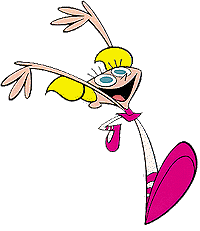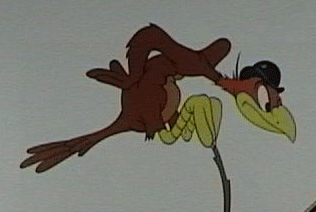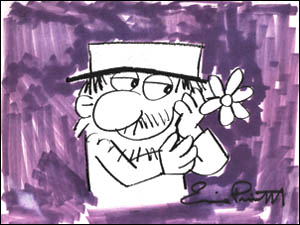Overcoming Barriers to Creative Collaboration
One of the more interesting topics of discussion these days is how to leverage the technology available to help smaller independent animation producers become more successful. A major concept that we have been employing is that of the virtual studio, the virtual production team, the collaboration of artists and creators beyond the limitations of a single geography. The term virtual studio refers to a team of creators and contributors who do not necessarily share a common geographic location and who may or may not belong to a common organization or company. They may in fact be members of different organizations or independent contractors. They have joined together to work on a common project or projects and have determined that they will adjust to and overcome boundaries.

In the age of Internet communications there truly are no boundaries to collaboration. Certainly distance is no boundary as demonstrated by the very diverse nature of the people from different countries who interact daily via the web. We live on an ever shrinking planet. This means that not only do producers of Internet distributed content have access to a global audience; we also have access to global collaborative participation in our productions. Unlike many of the major cartoon studios we aren’t globalizing to capitalize on less expensive labor but rather to gain a synergistic advantage by expanding our pool of collaborative talent.
Is there really much difference in direct Internet communications with the person in the office down the hall or across the globe? Are there any real barriers to sharing visual information or documents globally? The answers two both questions are mostly “no”. Are there tools that assist in making collaboration easier? Can virtual studios exist and function? Yes, they can, and yes they already do exist, and the trend is growing.
In truth, most commercial animated cartoon production today is performed across multiple locations and in fact around the globe. As an example, writing and storyboarding and voice recording for many cartoons series take place in the USA while the actual animation and post production are done in other countries such as Canada, Mexico, Japan, Korea, India etc. The title may be distributed under a studio banner like Disney or Warner Bros. and yet there are many subcontracting team member companies involved worldwide. This has been common business practice in the animation industry since the 1960's and 1970's. So the concept of the distributed studio is not new. Virtualization is just one step further in this expansion of collaboration.

The difference between distributed and virtual is mostly semantic, but basically what we are describing here is an independent virtual studio. That is the collaboration of small companies or groups of individual creators as opposed to the big commercial studios like Disney and Warner and which may or may not be anything more than a true “cottage” industry.
On the subject of collaboration, I previously posted a Between the Frames article Mark Simon Producing Animated Short Films Part 1 which recaps some of the conversations I had with Mark Simon at the recent Dragon Con gathering. There are some very insightful tips about how to form collaborations and to compensate people for their work.
(My apologies to Mark that I have never posted the second and follow up installment to that discussion. Maybe I'll do that some day.)
One of the great advantages of the technology provided around today's internet is a host of tools that facilitate collaboration. In our own production work we use many of these tools. For example we have set up a special development website which isn't public and affords us a place to post all of the aspects of our collaborative workflow for each collaborator to be able to access and review from anywhere any time. We have scripts posted, conceptual sketches and character designs, animated snippets (just quick little tests), story boards and animatics, and of course productions in process. It is always quite amazing to see the amount of materials that are behind the scenes that get created but aren't specifically just the final cartoon. It is also fun to watch the evolution of ideas and concepts as they change during a production. There is also an additional benefit to this repository; it provides a new perspective about the creative work. It never ceases to amaze me how going back and looking at drawings a second, third or forth time and looking at them in a context of other sketches or film clips sparks new ideas and different reactions.

In addition to our private website, we of course actively use e-mail, and there is a constant flurry of notes and sketches and clips going back and forth. And we also use an instant messaging system to have real-time collaborations. We can all be viewing a story board or animatic on the website and also be chatting away just like we were all in the same room together discussing the panels and deciding on additional panels or different shots or changes to how a sequence will develop. Lately we have even started using digital ink as a way to sketch thoughts and ideas right in the messaging window as we converse. Capturing those dialogues becomes a great tool for documenting our creative exchanges.
The real lesson to be learned here is that there are no real barriers to making cartoons with other like minded creators at least no distance barriers. Geography isn't a problem. The real secret to collaboration, whether in one place or geographically dispersed is the collaboration participants. Finding and building working relationships is the key. That requires significant effort but is hugely rewarding both personally and professionally. It is also quite a good way to develop great friendships. If you work with someone for very long you will hopefully not only produce some creative results, you will make good friends.
Any collaboration requires the development of mutual respect and consideration. It requires real commitment and a lot of patience. Artistic egos have to be tempered and balanced as well. One aspect of a potentially successful artistic collaboration is developing relationships with potential collaborators. To reinforce that point, I can't stress enough that collaboration is greatly enhanced by individuals taking the time to develop personal relationships and truly getting to know each other before they embark on this type of working relationship. By getting to know each other better and developing common areas of interest you invest more into the process. As your personal investment rises, your respect levels hopefully rise and your tolerance levels also should rise. The very nature of collaboration requires individuals to be willing to participate in a give and take mutually beneficial effort. The more your interact with a person the better you can judge whether or not they are willing and more importantly capable of this type of relationship, and conversely they are better able to evaluate your willingness and capability. Honestly, not everyone is capable of working with other people. They may want to, they may need to, but it may not be within their personality.
Perhaps the biggest mistake a person can make going into a collaboration project is to assume that you can just throw a group of strangers together and they can work as a team. Team building is a skill and gaining and maintaining consensus for collaborative work takes time and patience. A collaborative project requires commitment and follow through, anyone wanting to do collaborative work, even just for fun and experience, must appreciate the fact that although the quality of their work may not be at issue, the reliability of their actions is most certainly apparent.

One of the most critical things in determining if someone would make a good collaborative partner is whether or not they are reliable. There will always be creative and artistic issues but a successful collaboration can not tolerate failures to uphold and complete commitments. That is an unacceptable sin.
Collaborations are hard work and they require significant effort to establish and develop but what they don’t require is for the collaborators to physically be in the same room or city or even the same country. The keys are a common vision and the desire to create and, yes, a lot of patience.

In the age of Internet communications there truly are no boundaries to collaboration. Certainly distance is no boundary as demonstrated by the very diverse nature of the people from different countries who interact daily via the web. We live on an ever shrinking planet. This means that not only do producers of Internet distributed content have access to a global audience; we also have access to global collaborative participation in our productions. Unlike many of the major cartoon studios we aren’t globalizing to capitalize on less expensive labor but rather to gain a synergistic advantage by expanding our pool of collaborative talent.
Is there really much difference in direct Internet communications with the person in the office down the hall or across the globe? Are there any real barriers to sharing visual information or documents globally? The answers two both questions are mostly “no”. Are there tools that assist in making collaboration easier? Can virtual studios exist and function? Yes, they can, and yes they already do exist, and the trend is growing.
In truth, most commercial animated cartoon production today is performed across multiple locations and in fact around the globe. As an example, writing and storyboarding and voice recording for many cartoons series take place in the USA while the actual animation and post production are done in other countries such as Canada, Mexico, Japan, Korea, India etc. The title may be distributed under a studio banner like Disney or Warner Bros. and yet there are many subcontracting team member companies involved worldwide. This has been common business practice in the animation industry since the 1960's and 1970's. So the concept of the distributed studio is not new. Virtualization is just one step further in this expansion of collaboration.

The difference between distributed and virtual is mostly semantic, but basically what we are describing here is an independent virtual studio. That is the collaboration of small companies or groups of individual creators as opposed to the big commercial studios like Disney and Warner and which may or may not be anything more than a true “cottage” industry.
On the subject of collaboration, I previously posted a Between the Frames article Mark Simon Producing Animated Short Films Part 1 which recaps some of the conversations I had with Mark Simon at the recent Dragon Con gathering. There are some very insightful tips about how to form collaborations and to compensate people for their work.
(My apologies to Mark that I have never posted the second and follow up installment to that discussion. Maybe I'll do that some day.)
One of the great advantages of the technology provided around today's internet is a host of tools that facilitate collaboration. In our own production work we use many of these tools. For example we have set up a special development website which isn't public and affords us a place to post all of the aspects of our collaborative workflow for each collaborator to be able to access and review from anywhere any time. We have scripts posted, conceptual sketches and character designs, animated snippets (just quick little tests), story boards and animatics, and of course productions in process. It is always quite amazing to see the amount of materials that are behind the scenes that get created but aren't specifically just the final cartoon. It is also fun to watch the evolution of ideas and concepts as they change during a production. There is also an additional benefit to this repository; it provides a new perspective about the creative work. It never ceases to amaze me how going back and looking at drawings a second, third or forth time and looking at them in a context of other sketches or film clips sparks new ideas and different reactions.

In addition to our private website, we of course actively use e-mail, and there is a constant flurry of notes and sketches and clips going back and forth. And we also use an instant messaging system to have real-time collaborations. We can all be viewing a story board or animatic on the website and also be chatting away just like we were all in the same room together discussing the panels and deciding on additional panels or different shots or changes to how a sequence will develop. Lately we have even started using digital ink as a way to sketch thoughts and ideas right in the messaging window as we converse. Capturing those dialogues becomes a great tool for documenting our creative exchanges.
The real lesson to be learned here is that there are no real barriers to making cartoons with other like minded creators at least no distance barriers. Geography isn't a problem. The real secret to collaboration, whether in one place or geographically dispersed is the collaboration participants. Finding and building working relationships is the key. That requires significant effort but is hugely rewarding both personally and professionally. It is also quite a good way to develop great friendships. If you work with someone for very long you will hopefully not only produce some creative results, you will make good friends.
Any collaboration requires the development of mutual respect and consideration. It requires real commitment and a lot of patience. Artistic egos have to be tempered and balanced as well. One aspect of a potentially successful artistic collaboration is developing relationships with potential collaborators. To reinforce that point, I can't stress enough that collaboration is greatly enhanced by individuals taking the time to develop personal relationships and truly getting to know each other before they embark on this type of working relationship. By getting to know each other better and developing common areas of interest you invest more into the process. As your personal investment rises, your respect levels hopefully rise and your tolerance levels also should rise. The very nature of collaboration requires individuals to be willing to participate in a give and take mutually beneficial effort. The more your interact with a person the better you can judge whether or not they are willing and more importantly capable of this type of relationship, and conversely they are better able to evaluate your willingness and capability. Honestly, not everyone is capable of working with other people. They may want to, they may need to, but it may not be within their personality.
Perhaps the biggest mistake a person can make going into a collaboration project is to assume that you can just throw a group of strangers together and they can work as a team. Team building is a skill and gaining and maintaining consensus for collaborative work takes time and patience. A collaborative project requires commitment and follow through, anyone wanting to do collaborative work, even just for fun and experience, must appreciate the fact that although the quality of their work may not be at issue, the reliability of their actions is most certainly apparent.

One of the most critical things in determining if someone would make a good collaborative partner is whether or not they are reliable. There will always be creative and artistic issues but a successful collaboration can not tolerate failures to uphold and complete commitments. That is an unacceptable sin.
Collaborations are hard work and they require significant effort to establish and develop but what they don’t require is for the collaborators to physically be in the same room or city or even the same country. The keys are a common vision and the desire to create and, yes, a lot of patience.

1 Comments:
Good stuff, i really like the private website idea.gonna try.
Post a Comment
<< Home